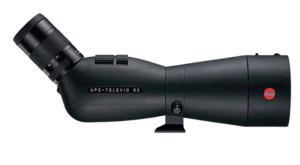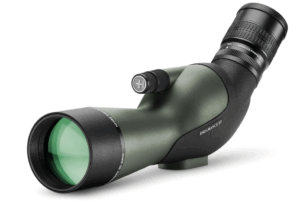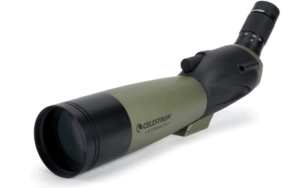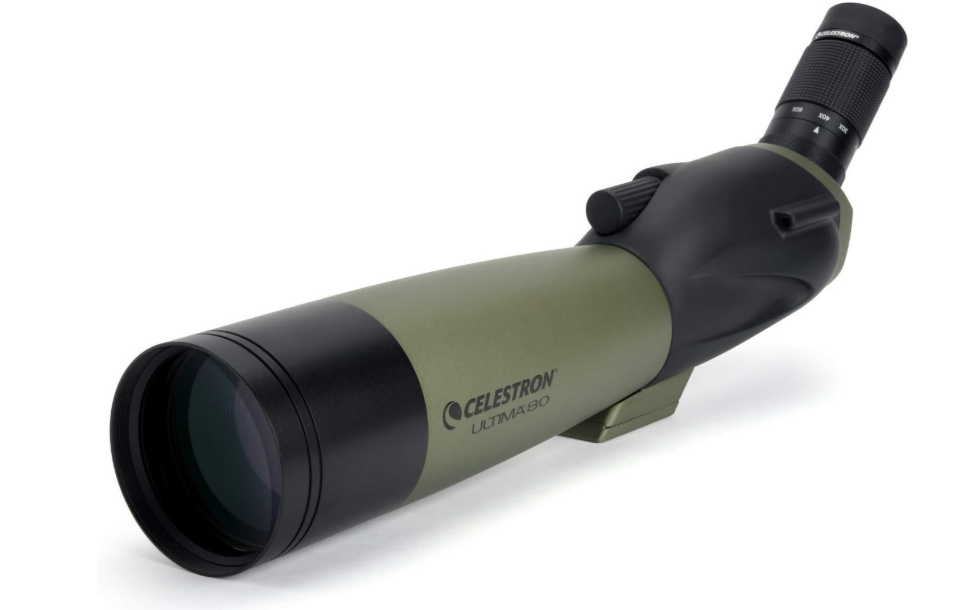Best Scope for Bird Watching
1) Swarovski ATS 80 20-60X Spotting Scope

The Swarovski ATS 80 20-60X Spotting Scope is one of the Best Scope for Bird Watching, it features; Exceptional image quality with fluoride-containing HD lenses, Bright, sharp views thanks to excellent light transmission among other incredible features.
The Swarovski ATS 80 20-60X Spotting Scope is a premium high-definition optical instrument designed for serious birdwatchers and outdoor enthusiasts. Featuring an impressive 80mm objective lens, it delivers outstanding light transmission, ensuring bright and crisp views even in low-light conditions or at higher magnifications.
Its fluoride-containing HD lenses minimize color fringing and provide high-contrast, true-to-life images, making it easier to spot fine plumage details or distant wildlife. The included 20-60X eyepiece comes with individual twist-in eyecups for comfortable, customized viewing, whether you wear glasses or not.
Measuring just under 14 inches in length and weighing 45.2 ounces, this spotting scope combines portability with durability, built into a rugged aluminum housing that withstands challenging field conditions. With Swarovski’s renowned craftsmanship and a lifetime warranty, the ATS 80 stands as a long-term investment for anyone seeking the highest level of optical clarity and reliability.
Pros
-
Exceptional image quality with fluoride-containing HD lenses
-
Bright, sharp views thanks to excellent light transmission
-
Wide zoom range (20-60X) with comfortable twist-in eyecups
-
Rugged aluminum construction for durability in the field
-
Lightweight for an 80mm spotting scope and highly portable
-
Backed by a reliable lifetime warranty
Cons
-
Premium price may be too high for casual users
2) Celestron – Regal M2 80ED Spotting Scope

The Celestron Regal M2 80ED Spotting Scope is one of the Best Scope for Bird Watching, it features; Extra-low dispersion glass for razor-sharp, true-to-life images, Proprietary XLT coatings maximize brightness and clarity among other incredible features.
The Celestron Regal M2 80ED Spotting Scope is a versatile, high-performance option for birdwatchers, nature observers, and digiscopers seeking premium features at a more accessible price point. Its extra-low dispersion (ED) glass lens delivers razor-sharp detail and excellent color correction, dramatically reducing chromatic aberration for lifelike, high-contrast images.
Enhanced by Celestron’s proprietary XLT fully multi-coated optics; technology borrowed from observatory-class telescopes; this scope ensures maximum light transmission, resulting in brighter, clearer views even in dim lighting conditions. Equipped with a 20-60x zoom eyepiece, the Regal M2 also accepts standard 1.25” astronomical eyepieces, while the rotating tripod mount makes it easy to achieve the most comfortable viewing angle.
Designed for convenience, it comes with a padded view-through case, protective covers, a T-mount adapter for DSLR digiscoping, and other useful accessories. With a rugged build, excellent optics, and the backing of Celestron’s Limited Lifetime Warranty and expert US-based support, the Regal M2 80ED is a field-ready spotting scope that combines durability, clarity, and value.
Pros
-
Extra-low dispersion glass for razor-sharp, true-to-life images
-
Proprietary XLT coatings maximize brightness and clarity
-
Wide zoom range (20-60x) plus compatibility with 1.25” eyepieces
-
Rotating tripod mount allows flexible, comfortable viewing angles
-
Includes accessories for protection and DSLR digiscoping
-
Strong warranty and trusted customer support from Celestron
Cons
-
Heavier than more compact spotting scopes
3) Leica APO-Televid 82 Angled Spotting Scope

The Leica APO-Televid 82 Angled Spotting Scope is one of the Best Scope for Bird Watching, it features; Exceptional color brilliance, contrast, and sharpness with apochromatic optics, Dual focus mechanism for both fast and precise focusing among other incredible features.
The Leica APO-Televid 82 Angled Spotting Scope is engineered for professional birdwatchers and nature enthusiasts who demand exceptional optical performance. With its 82mm objective lens and apochromatic optics, this scope delivers outstanding brightness, color fidelity, and sharpness, ensuring every feather detail and subtle hue is captured with precision.
Its innovative dual focus system allows for rapid coarse adjustments and precise fine-tuning, giving you sharp relief of even the most distant subjects. The magnesium housing, reinforced with non-reflective matte-black rubber armoring, provides durability, shock resistance, and a secure grip for reliable use in any environment.
Designed for the outdoors, the APO-Televid 82 is water pressure-tight up to 5 meters and filled with nitrogen to prevent internal fogging, while Leica’s AquaDura coating repels dirt, water, and oil for clear viewing in all conditions.
Angled viewing aids in quick target acquisition, and when paired with the recommended 25-50x wide-angle aspherical eyepiece, users benefit from an expansive field of view ranging from 41m to 28m per 1,000m. Combining rugged reliability with superior optics, the APO-Televid 82 stands as one of the most refined spotting scopes in the field.
Pros
-
Exceptional color brilliance, contrast, and sharpness with apochromatic optics
-
Dual focus mechanism for both fast and precise focusing
-
Large 82mm objective lens ensures bright, natural views even in low light
-
Rugged magnesium housing with non-reflective rubber armoring for durability
-
Waterproof (up to 5m) and fog-resistant with nitrogen filling and AquaDura coating
-
Angled viewing design with wide-angle eyepiece option for expansive field of view
Cons
-
Premium price may be prohibitive for casual users
4) Hawke Endurance ED Compact Spotting Scope

The Hawke Endurance ED Compact Spotting Scope is a lightweight, portable solution for birdwatchers and outdoor enthusiasts who want premium optical performance in a compact form. Featuring a 60mm objective lens with a versatile 15-45x magnification range, this angled spotting scope provides excellent detail and clarity for both mid- and long-distance viewing.
Its Extra-low Dispersion (ED) glass, combined with dielectric-coated BAK4 prisms, delivers razor-sharp images with superior color accuracy, brightness, and contrast while minimizing chromatic aberration. Fully waterproof and nitrogen-purged, it performs reliably in all weather conditions, giving users confidence in the field.
Built with durability and portability in mind, the Endurance ED Compact is easy to carry and rugged enough for frequent outdoor use, making it a dependable companion for birdwatching, nature observation, or travel.
Pros
-
ED glass and dielectric-coated BAK4 prisms provide sharp, high-contrast images
-
Versatile 15-45x magnification ideal for a range of distances
-
Compact and lightweight design for easy portability
-
Angled eyepiece allows comfortable, extended viewing sessions
-
Fully waterproof and nitrogen-purged for all-weather performance
-
Durable construction suited for outdoor field use
Cons
-
Smaller 60mm objective lens gathers less light than larger models, limiting low-light performance
5) Celestron 52250 Ultima 20-60x80mm

The Celestron 52250 Ultima 20-60x80mm Spotting Scope is a versatile, all-around optical tool designed for outdoor enthusiasts, birdwatchers, and nature observers. With its large 80mm objective lens and 20-60x zoom capability, it delivers bright, detailed views of distant subjects, while the 45° angled eyepiece ensures comfortable long-term use.
Every lens surface is fully multi-coated with anti-reflective coatings to maximize brightness, enhance contrast, and improve color accuracy, making it well-suited for use even in dim lighting conditions. The scope’s large focus dial allows fast and precise adjustments, bringing subjects into razor-sharp focus before they disappear from view.
The included zoom eyepiece features an integrated T-adapter, enabling easy DSLR digiscoping for capturing close-up images of wildlife. Celestron equips the Ultima 80 with thoughtful extras such as a soft carrying case, extended tripod mounting plate, eyepiece pouch, and lens cloth, ensuring you have everything needed for field use.
Backed by Celestron’s Limited Lifetime Warranty and US-based technical support, the Ultima 80 offers both performance and peace of mind at a great value.
Pros
-
Large 80mm objective lens provides bright, detailed images
-
20-60x zoom range ideal for versatile nature and long-distance viewing
-
Fully multi-coated optics improve brightness, contrast, and color fidelity
-
Angled eyepiece allows comfortable viewing over long sessions
-
Integrated T-adapter enables easy DSLR digiscoping
-
Comes with useful accessories and protective carrying case
-
Strong warranty and trusted Celestron customer support
Cons
-
Bulkier and heavier than compact spotting scopes
Factors to Consider When Choosing the Best Scope for Bird Watching
1. Magnification and Zoom Range
One of the most important factors when selecting a spotting scope for bird watching is the magnification and zoom range. Most scopes offer a range such as 15–45x or 20–60x, giving flexibility for both close and distant observations.
Lower magnification provides a wider field of view, making it easier to track moving birds, while higher magnification helps capture fine details, such as plumage or markings, at longer distances.
However, higher zoom levels often require a sturdy tripod for stability and may reduce brightness. Choosing a scope with a versatile zoom range ensures you can adapt to different birding environments, whether in open wetlands or forested areas.
2. Objective Lens Diameter
The size of the objective lens directly impacts how much light the scope can gather, which affects brightness, clarity, and performance in low-light conditions. Larger lenses, such as 80mm or 82mm, excel in providing brighter images and superior detail at high magnification, making them ideal for early morning or dusk birding.
However, bigger lenses also add weight and bulk, which can make the scope less portable. Smaller lenses, such as 60mm, are more compact and travel-friendly but may sacrifice some brightness. Striking the right balance between lens size and portability is essential depending on how and where you plan to bird watch.
3. Optical Glass and Coatings
The quality of the glass and lens coatings significantly influences image sharpness and color accuracy. Extra-low dispersion (ED), high-definition (HD), or apochromatic (APO) lenses minimize chromatic aberration, reducing color fringing and ensuring lifelike, high-contrast images.
Additionally, fully multi-coated optics, such as Celestron’s XLT coatings, maximize light transmission, improve clarity, and enhance brightness, especially in dim lighting. For birders who value precise details; like identifying subtle differences between species;investing in premium glass and coatings makes a noticeable difference in the viewing experience.
4. Eyepiece Design and Comfort
Comfortable viewing is crucial during extended birdwatching sessions, and the eyepiece design plays a big role. Many scopes feature angled eyepieces, which are favored for prolonged use and make it easier to share the scope with others at different heights. Adjustable or twist-in eyecups add comfort, especially for those who wear glasses.
Some spotting scopes also allow interchangeable eyepieces, including wide-angle or high-power models, giving you more flexibility. A well-designed eyepiece not only enhances comfort but also ensures you can enjoy long hours of birding without eye strain.
5. Build Quality and Weather Resistance
Since birdwatching often takes place outdoors in varying weather, durability and weather resistance are essential. A rugged body—commonly made of magnesium or aluminum and often reinforced with rubber armoring; protects the scope from impacts and provides a secure grip.
Waterproof and fog-proof designs, often achieved through nitrogen or argon purging, ensure the scope performs reliably in rain, humidity, or sudden temperature changes. Coatings like Leica’s AquaDura also repel dirt, water, and oil for clearer lenses in tough conditions.
A scope that can withstand the elements becomes a dependable companion no matter where your birding adventures take you.
6. Portability and Weight
The portability of a spotting scope is a major consideration, especially for birders who hike or travel. Larger models with 80–82mm lenses provide excellent brightness and detail but can be heavy and cumbersome to carry long distances.
Compact options with 50–60mm lenses trade some optical performance for lighter weight and greater mobility, making them better suited for travel or casual outings. Birders must decide whether they prioritize optical power or portability, as the right choice depends on how often and how far they plan to carry their scope.
7. Tripod Compatibility
Stability is vital when using high magnification, and that’s where tripod compatibility comes in. Most spotting scopes include a rotating tripod mount that allows users to adjust viewing angles easily.
However, heavier scopes require more robust tripods for steady images, particularly at higher zoom levels. Investing in a solid, compatible tripod not only enhances image sharpness but also reduces hand fatigue during prolonged sessions.
For bird watchers, pairing the right scope with the right tripod ensures a smoother and more enjoyable experience.
8. Accessories and Extras
Many spotting scopes include accessories that enhance the overall birdwatching experience. Essentials such as carrying cases, lens covers, and cleaning cloths help protect the scope and maintain clarity in the field.
Some models, like Celestron’s, even include T-adapters for digiscoping, allowing users to attach DSLR cameras and capture stunning close-up images of birds. While not strictly necessary, these extras add convenience and value, making the scope more versatile and ready to use straight out of the box.
9. Price and Value
Finally, budget plays an important role in choosing the best spotting scope. Premium models from brands like Swarovski, Leica, or Kowa offer unmatched optical quality, but their high price may not suit beginners or casual birders.
Mid-range options, such as Celestron Regal M2 or Vortex Viper HD, strike a good balance between performance and affordability, while budget-friendly scopes like the Celestron Ultima 80 still provide solid performance for entry-level birding.
The key is to choose a scope that fits your needs and budget, offering the best value without compromising too much on essential features.
FAQs
1. What magnification is best for bird watching with a spotting scope?
Most bird watchers find a zoom range of 15-45x or 20-60x ideal. Lower magnification offers a wider field of view, making it easier to track moving birds, while higher magnification helps you observe fine plumage details at longer distances. However, very high zoom levels require a sturdy tripod for stability and may reduce image brightness.
2. Is a bigger objective lens always better for bird watching?
Not always. A larger objective lens, such as 80–82mm, gathers more light and provides brighter images, especially in low-light conditions like dawn or dusk. This is excellent for detailed bird observation. However, larger lenses make the scope heavier and less portable. Smaller lenses, such as 50–60mm, are more lightweight and travel-friendly but may sacrifice some brightness. The right choice depends on whether you prioritize image quality or portability.
3. What features make a spotting scope reliable for outdoor bird watching?
For reliable performance in the field, look for scopes with ED or HD glass to minimize color fringing, fully multi-coated optics for brightness and clarity, and rugged weatherproof construction to handle rain, fog, and temperature changes. Features like a rotating tripod mount, angled eyepiece, and comfortable twist-in eyecups also enhance usability. A good balance of optical quality, durability, and portability ensures the best experience.
Read Also : Best Scope for 22 Mag

